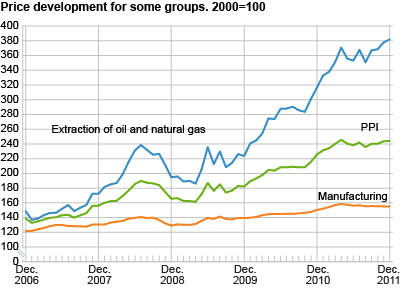Content
Published:
This is an archived release.
Small rise in the PPI
The producer price index (PPI) increased by 0.2 per cent from November to December. A higher price for natural gas was the main cause, while lower prices of oil, refined petroleum products, metals and electricity pulled the index down.
The PPI rose by 0.2 per cent from November to December. The price rise is manly due to higher prices of natural gas. Price of crude oil (Brent Blend) went down by 0.7 per cent in the period. Prices of electricity fell 6.9 per cent because of the lower demand for electricity in the last week of December, as well as the high water level in the Norwegian water reservoirs.
Price decline in manufacturing
Prices in manufacturing as a whole fell by 0.1 per cent as a result of price reductions in several key industries. Prices in refined petroleum products fell by 0.6 per cent, while basic metals went 1.3 per cent down from November to December. Lower prices in basic metals came from the decline in global prices of non-ferrous metals. Lower prices in food products were caused by cheaper meat sold to Norwegian customers.
Chemical and pharmaceutical products as well as machinery and equipment were two industries with a price increase from November to December.
Twelve-month growth: 8.2 per cent higher prices
From December 2010 to December 2011, the PPI increased by 8.2 per cent. The price increase was mainly caused by higher prices in extraction of oil and natural gas, refined petroleum products and food products. Prices of electricity and basic metals helped curb the growth in the twelve-month period.
Annual growth: 16.3 per cent
The PPI rose by 16.3 per cent from 2010 to 2011, compared with a rise of 18.3 per cent from 2009 to 2010. The main contributors were extraction of oil and natural gas together with refined petroleum products. Among other industries crucial to the annual growth were food products, chemical and pharmaceutical products, paper and paper products, and basic metals. Prices of electricity fell, however, from 2010 to 2011 and helped curb the annual growth in the PPI.
Highlights for 2011
In 2011, the PPI was characterised by high prices in extraction of oil and natural gas. Basic metals and electricity were two groups that experienced falling prices through the year.
Prices in extraction of oil and natural gas were 29.2 per cent higher in 2011 compared with 2010. Price development in the industry in 2011 was characterised by high but volatile prices. Oil prices increased sharply from January to April, but fell through the rest of the year. As such, the average oil price in 2010 was about 80 US dollars per barrel, while in 2011 it was well above 100 dollars per barrel. Prices of natural gas have had an upward trend throughout 2011.
The annual growth in prices of the basic metals was 6.2 per cent in 2011. This is significantly lower than in 2010, when the growth was over 20 per cent. Prices of basic metals have been falling through the year, and both iron and steel, as well as non-ferrous metals have contributed to the price fall.
Lower electricity prices
With about 8 per cent lower prices in 2011 compared to 2010, electricity prices reduced the annual growth in PPI. This must be seen together with the sharp growth in electricity prices during the autumn in 2010, due to low reservoir levels and cold weather. Periods of 2011 were characterised by heavy precipitation, which led to a sharp recovery of the reservoir levels. The large inflow of water and risk of overflow in many reservoirs may have led to increased production, and in turn, lower prices.
| December 2011 | Changes, per cent | ||||||||||||||||||||||||||||||||||||||||||||||||||||||||||||||||||||||||||||||
|---|---|---|---|---|---|---|---|---|---|---|---|---|---|---|---|---|---|---|---|---|---|---|---|---|---|---|---|---|---|---|---|---|---|---|---|---|---|---|---|---|---|---|---|---|---|---|---|---|---|---|---|---|---|---|---|---|---|---|---|---|---|---|---|---|---|---|---|---|---|---|---|---|---|---|---|---|---|---|---|
| November 2011-December 2011 | December 2010-December 2011 | ||||||||||||||||||||||||||||||||||||||||||||||||||||||||||||||||||||||||||||||
| Total index | 244.1 | 0.2 | 8.2 | ||||||||||||||||||||||||||||||||||||||||||||||||||||||||||||||||||||||||||||
| Extraction of oil and natural gas | 381.9 | 1.1 | 20.6 | ||||||||||||||||||||||||||||||||||||||||||||||||||||||||||||||||||||||||||||
| Manufacturing, mining and quarrying | 155.0 | -0.2 | 3.0 | ||||||||||||||||||||||||||||||||||||||||||||||||||||||||||||||||||||||||||||
| Electricity, gas and steam supply | 245.9 | -6.9 | -43.1 | ||||||||||||||||||||||||||||||||||||||||||||||||||||||||||||||||||||||||||||
| Main industrial groupings | |||||||||||||||||||||||||||||||||||||||||||||||||||||||||||||||||||||||||||||||
| Intermediate goods | 142.0 | -0.2 | -0.7 | ||||||||||||||||||||||||||||||||||||||||||||||||||||||||||||||||||||||||||||
| Investment goods | 127.8 | 0.2 | 0.9 | ||||||||||||||||||||||||||||||||||||||||||||||||||||||||||||||||||||||||||||
| Consumer goods | 133.6 | - | 3.6 | ||||||||||||||||||||||||||||||||||||||||||||||||||||||||||||||||||||||||||||
| Energy goods | 354.9 | 0.5 | 14.3 | ||||||||||||||||||||||||||||||||||||||||||||||||||||||||||||||||||||||||||||
For information on the commodity price index for the industrial sectors, see http://www.ssb.no/vppi_en
Additional information
Contact
-
Producer price index
E-mail: produsentpris@ssb.no
tel.: (+47) 21 09 40 00
-
Elisabeth Mælum
E-mail: elisabeth.maelum@ssb.no
tel.: (+47) 97 01 28 49
-
Morten Madshus
E-mail: morten.madshus@ssb.no
tel.: (+47) 40 90 26 94
-
Monika Græsli Engebretsen
E-mail: monika.graesli.engebretsen@ssb.no
tel.: (+47) 40 90 23 71
-
Håvard Georg Jensen
E-mail: havard.jensen@ssb.no
tel.: (+47) 40 90 26 86

